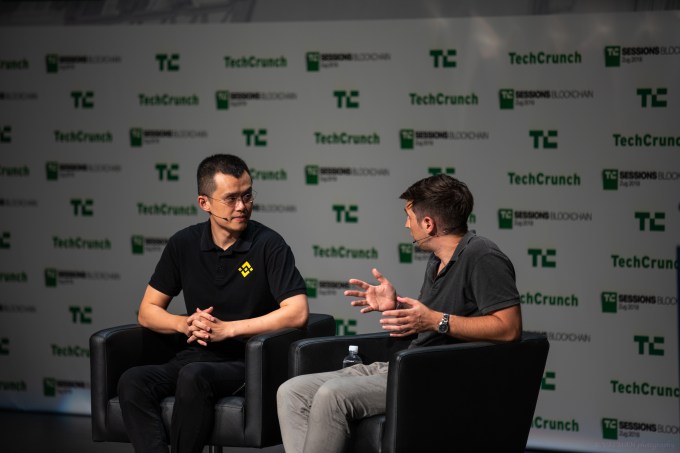Binance, the one-year-old startup that appeared from nowhere to become the world’s top crypto exchange, is making major moves as it enters the next phase of its business. That includes a plan to offer fiat-to-crypto trading in international markets and the release of a decentralized exchange to complement its current trading site.
The company routinely trades more than $1 billion in crypto volumes daily — even in this current bear market — but to date it has only allowed crypto-to-crypto trading. That’s primarily down to the need for regulation in order to offer fiat currency conversation, but that’s set to change.
Speaking at a Coindesk event in Singapore last week, CEO Changpeng “CZ” Zhao revealed plans to launch a slew of local exchanges offering fiat conversation in markets across the world and he provided further details in an interview with TechCrunch.
“Right now, we are centralized crypto-to-crypto,” Zhao told us. “We don’t offer fiat gateways and so we rely on others to do that. But through discussions with different regulators across the world, we now have those channels. We want to make it easier for fiat currency to get into the crypto world.”
There’s certainly a need for institutional money. Crypto prices are down as much as 55 percent on January’ highs, according to analysis from Bloomberg, so it figures that major players like Binance need the backing of big names and large amounts to reverse the trend. While many in the space say they are happy to see a low price since it drives out less sincere operators, dwindling interest in crypto isn’t ideal for those who get paid by facilitating trades.
Zhao said the plan is to open three fiat exchanges this year with a view to growing the number to 10 in 2019, with “ideally two per continent.” Part of the goal is to help larger, institutional investors bring money into the crypto ecosystem, a move that would help Binance and the rest of the industry, too.
“We want to” reach both retail and institutional investors he added. “Our target has always been more retail focused, but now institutions are coming into crypto and we are seeing that.”

Binance CEO Changpeng “CZ” Zhao speaks at TechCrunch’s blockchain event in Zug in July 2018 [Image: Daniel Vaiman/Explore To Create]
While he didn’t specifically call out other markets that Binance is looking at, he did rule out launching in China, Japan and the U.S, which are three major markets for crypto despite respective legal roadblocks. China banned ICOs and exchanges some time ago, the U.S. has begun cracking down on crypto and Japan has tight licensing around exchanges which, for one thing, imposes regulations on what tokens can be listed on exchanges.
“Japan is progressive on crypto but their exchange regulation is too strict,” Zhao said. “It makes it very hard for exchanges.”
Indeed, it stands to reason that Binance — which once had an office in Tokyo before deciding against operating a local entity — would need to modify its token selection in line with Japanese laws were it to gain a license to operate in Japan. Either way, Zhao doesn’t seem key to reevaluate the country just yet.
Elsewhere, Zhao said he “respects” China’s decision to ban ICOs and exchanges, while he is happy to let others do the heavy lifting in the U.S.
“We are interested in the U.S. but that’s not a top priority and we will probably let the other guys go in first,” he told TechCrunch.
Binance — which has flocked to crypto-friendly nations like Malta and Bermuda — said it would open an office in Singapore should the proposed exchange rollout go successfully.
Beyond fiat, the company is also getting closer to launching a decentralized exchange (dex) which would allow buyers and sellers to trade tokens directly without the exchange acting as an intermediatory.
High-profile figures have criticized central exchanges. Ethereum creator Vitalik Buterin went so far as to say that they should “burn in hell” for their position controlling asset selection, price and more. Binance seems to be making as much progress as anyone with its dex which, simply because of the company’s market position, could force others to follow suit.
The Binance dex would significantly alter the trading flow as it stands today, but Binance itself — which Zhao told Coindesk made a profit of $350 million over the past six months — would still draw revenue. That’s because the dex would operate on Binance’s own blockchain with the company operating a number of nodes itself. Zhao said that when its nodes are used in transactions, it would gain some of the network fee.
While, equally, the firm stands to profit from increased dex use because that could make Binance’s BNB token more valuable, Zhao argued.
The company recently released a very early demo of the dex — spoiler alert: it is underwhelming — but Zhao said a fully-working service should be available by the end of this year or early 2019 at the latest. The Binance CEO, who once build software for futures trading for Bloomberg, is leading the development of the project.
“Development is going well,” he added. “Our dex is very simple but it’s fast.”
Beyond its exchange business, Binance is also putting itself to work on growing the crypto industry. Earlier this year it announced an investment fund that it said is worth $1 billion and would invest directly into companies and new crypto investment funds, too. It also has aggressive plans to run early-stage accelerator programs across the world to help develop new businesses that support the crypto ecosystem.
Ellie Zhang, who runs the Binance Labs division that manages both projects, candidly told TechCrunch last month that real use cases for blockchain and crypto are crucial if Binance is to “thrive” as a business.
Note: The author owns a small amount of cryptocurrency. Enough to gain an understanding, not enough to change a life.
from TechCrunch https://ift.tt/2NH91zS

0 coment�rios: